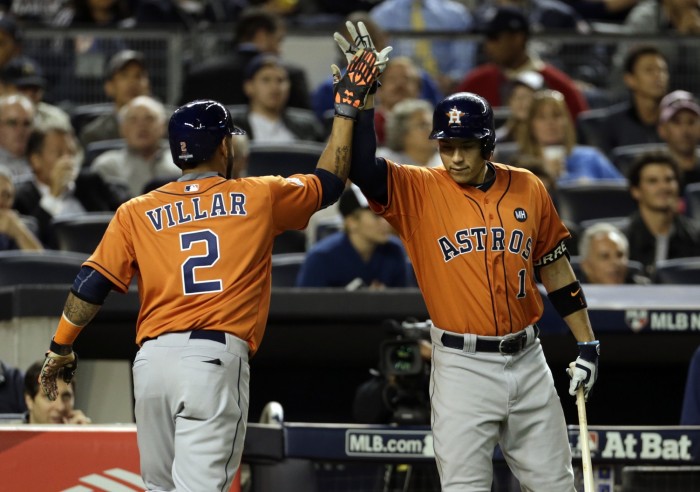On Thursday, the Brewers and Astros completed a relatively significant trade (in that it actually involved a Major League player) that sent shortstop Jonathan Villar from Houston to Milwaukee in exchange for minor-league right-hander Cy Sneed. This deal gives the Brewers extra middle-infield depth without sacrificing an impact prospect, which makes it a net positive for the club.
Sneed, a 23-year-old starting pitcher, is not a very exciting prospect. He has posted decent strikeout and walk numbers in the low minors, but he was drafted out of college and isn’t particularly young for his level. BP’s own Mauricio Rubio described him as a “backend profile for sure” in a chat earlier this year, which is valuable, but not franchise-defining in any way. Also, of course, young pitchers carry their own additional risk even beyond the uncertainties all prospects carry; an ill-timed injury or stagnated development is a far bigger problem for a pitcher than it would be for a position player.
Villar, on the other hand, is already a proven big leaguer. He’s not a star by any means: In roughly a season’s worth of plate appearances over the last three years (658), he has been worth a total of 2.0 WARP, which makes him roughly an average player. Also, he is just 24 years old, meaning that he is — at least in theory — on the upswing of his career. Admittedly, he isn’t likely to get substantially better, as scouting reports from as far back as 2011 question his ability to hit. Not to mention the fact that his minor-league numbers from each stop along the way support that idea (career .723 minor league OPS).
If one is looking to be optimistic, though, signs abound. His .270 TAv in (just) 128 plate appearances in 2015 was by far the highest of his career, and this number was supported (and likely buoyed) by a career-high contact percentage. For someone with his speed, simply putting the ball in play has some value. He has also proven to be roughly an average defensive shortstop, which is obviously not spectacular but is perfectly serviceable. His career FRAA of 1.0 does not make him a defensive standout but indicates that he is perfectly capable of remaining at the position.
This trade, though, is not so much about Villar the player as it is Villar the asset. He has proven that he can be a big-league shortstop, which is not really the case for anyone else on the Brewers’ roster other than Jean Segura. Elian Herrera may be counted on to start at third base or in left field and only has 91 innings at shortstop in the majors anyway, and Luis Sardinas has a career .688 OPS in the minors and .543 OPS in the majors. Thus, Segura was the only viable shortstop the Brewers really had prior to this point.
But acquiring Villar gives the Brewers a lot more flexibility. Orlando Arcia is on the verge of the Major Leagues, and the Brewers will want to give him the opportunity to earn playing time in 2015. They will not, however, want to force it upon him, and trading Segura this offseason without acquiring a backup may have done that. But not trading Segura would have made getting Arcia regular playing time far more difficult. After all, Segura is at this point a slight disappointment after the smashing start his career got off to, but he is still a young, league-average shortstop under team control through 2018, and the Brewers won’t want to squander some of his trade value by moving him to second base too early.
Villar, then, gives the Brewers some much-needed flexibility. They can keep Segura if no other team offers the right package, but they are not under any obligation to do so in order to protect Arcia. If the Brewers do unload Segura, Villar is a quality shortstop who can absolutely start for a couple months (or longer) without embarrassing himself until Arcia is ready. If the Brewers decide to hold onto Segura, Villar can be a backup or play second base.
Thus, perhaps an additional benefit to the trade is that it further marginalizes Scooter Gennett. A couple months ago, I wrote about how the young second baseman was simply not good enough to be a necessary part of the Brewers’ future, and this trade goes a long way to upgrading his roster spot. Villar is probably not the hitter Gennett is — although Gennett’s .233 2015 TAv may prove that statement false in the long run — but he provides much more defensive value simply by being able to play a competent shortstop. So even if Segura remains on the team and/or Arcia arrives in the big leagues to play shortstop every day, Villar can still be in the lineup or be a valuable bench player, which is not something that cannot be said for Gennett.
Overall, this trade is a bigger win for the Brewers than it initially seems on the surface, as Villar is not a hugely impactful player on the field. However, he is a good acquisition for a team that needs middle infield depth and flexibility. He will stabilize their big-league roster for the next couple years by providing a consistent up-the-middle bench option, and he also allows the new front office to be creative in terms of handling their more valuable shortstops in Segura and Arcia.

“Villar can still be in the lineup or be a valuable bench player, which is not something that cannot be said for Gennett.” You need to reread that sentence, pal.